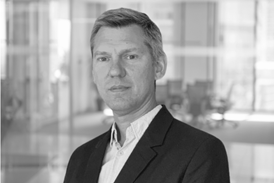When Ealing Council decided to consolidate its services on a low budget, Skanska and hurleypalmerflatt came to the rescue. Tracy Edwards finds out how value engineering can help the public sector tighten its purse strings.
Looking more like a municipal car park than Ealing Council’s stylish new hub of activity, Perceval House is certainly no beauty from the outside. But take a stroll through the new public entrance into a dazzling solar atrium with open plan waiting area and clean, contemporary lines, and you just might give a little more weight to the old maxim, it’s what’s on the inside that counts.
The £17 million refurbishment of 20-year-old Perceval House, Ealing Council’s principal office building, was undertaken to deliver a strong civic presence and to provide a central headquarters for the council’s 2250 office-based staff, who were co-located from nine different buildings in phases. A major advantage of consolidating services was the sale of surplus assets, which has enabled savings of £1.22 million. Ongoing savings will amount to £1.3 million per annum through efficiencies.
The scheme seeks to modernise and streamline the delivery of council services, enabling customers to contact the council 24 hours a day, seven days per week and to have 80% of their enquiries resolved at the first point of contact.
The 2000 m2 building houses a customer service centre, five office floors and a large first floor contact centre, supported by a multi-purpose business centre on the ground floor.
Hurleypalmerflatt was appointed as consultant for the challenging refit, and Skanska Rashleigh Weatherfoil provided the m&e services.
The refurbishment of the six-storey building was undertaken floor-by-floor, with services remaining live throughout and a minimum of four floors occupied at all times. Skanska’s m&e project manager Richard Mason says: “Doing things on a floor-by-floor basis meant we had quite a nice cycle going – it allowed us to focus more on the space we were working in and meant that we had no problems with overlapping trades.”
The project was delivered within a tight budget and programme. Work started on site in January 2005 and was completed in July 2006. A job of this scale and complexity would usually be allotted twice the time, and teething problems certainly didn’t help.
“The record designs and drawings weren’t complete and hadn’t been properly maintained, which meant there was a lot of research to do at the start of the project, because the brief was to retain as much of the existing plant as possible,” explains hurleypalmerflatt’s director Andrew Dellow.
“Integrating that specification with the new use of the building was a challenge, not least due to the sheer timescale,” says Dellow. “We really hit the ground running on 2 August, and we only had about ten weeks to get that to tender on the first stage. Albeit the contractors were fitting the whole job on design and build, so we were novated to the main contractor when he was appointed in January 2005. Then we had to complete the other two phases of detailed design over the following three or four months.”
Despite initial misgivings, the programme was completed on time and within budget. Skanska took a modular approach. “We were heavily into prefab right from the start,” says Mason. “All of the pipework was prefabricated – that in particular saved us a lot of time.”
Collaboration between the design team, which consisted of hurleypalmerflatt and architect Pringle Brandon, was central to the project’s success. “Being a complex building, the biggest challenge on the design side was taking a detailed brief of all the different uses within the space,” says Dellow. “They’ve got areas which are for the call centres and which are in operation 24/7 and, as you can imagine, there’s building control, social services – all the different sections that a council has are housed in this one building now, and they all work slightly differently.”
At the design stage, a forum was set up to enable the process to be completed in just six weeks. Consultation with council staff was crucial.
“The staff were going through a massive cultural change. A lot of them had come from different buildings where they’d been used to sitting by a window with their little filing cabinets in their own little worlds, so it was important to get them on our side,” says Dellow. “They didn’t have much choice in the move, but it’s always better if they understand they’re getting an improved facility.”
The building was occupied throughout. Limiting noisy work to times of the day when staff were not present introduced an element of difficulty. “It’s all about communication with the people in the building,” says Dellow. “You discuss it with them and pick the best times you can. You can’t do much about it, and people had to work some inconvenient hours, including weekends.”
A new public entrance was created, which was intended to give customers a delight factor as they enter the building. Way-finding and customer flow were central to the design solution, as was the creation of various moods for differing customer experiences. This was achieved by delivering an open, transparent environment and by distinguishing functions through the use of colour. “Now there’s a reception area with a glass atrium, new seating, colour and lighting,” enthuses Dellow. “And for a council building, it’s pretty impressive.”
Hurleypalmerflatt used 3D modelling to plan the office’s two atriums, located at either end of the spanner-shaped building (see plan, below). “They’re quite high, complex spaces and at various times of the day they’re directly exposed to sunlight, so we were trying to estimate environmental conditions during the year cycle,” says Dellow. “It was quite a complicated task for us, so we used Tas Building Designer (see box, below).”
For council staff, an open plan environment was created with a ratio of four desks to every five workers. There are 200 touchdown workstations, and quiet workspaces and meeting rooms are also provided. A modern building management system (bms), provided by Integrated Control Services, allows individual timing control. Before the refit, the plant would often run throughout the night when the building was empty. The bms also controls recirculation of air on the vav system.
Taking a sustainable approach, hurleypalmerflatt sought to reuse existing materials and retain original systems where viable. The consultant updated 85% of the systems in the entire building to accommodate increased occupancy and power requirement.
By the end of the project, over 350 km of data cabling had been installed and a new bespoke network design now provides wireless coverage throughout the entire building.
“Various departments had their own IT set-ups because they were all in different buildings. The commonality was a very small interface, whereas now it’s all part of a much more concise and accessible system,” explains Dellow.
Value engineering was always top of the list. “Being a council, the client didn’t want to be seen not partaking in sustainable construction,” says Dellow. “Having said that, the office was built before the current Part L requirements, which it now needs to comply with. We achieved that by introducing new control systems, so the energy management is much better than it was before. It didn’t have a modern control system before the refit, but now staff are able to set up the timing and the conditions which will save a lot more energy.”
The client wanted to retain existing plant where possible. Air conditioning was originally provided by a vav system, which was serviced from the roof. “We couldn’t get the vav to serve the whole building, so it had to be replaced on some floors,” explains Dellow. “As it was serviced from the roof, it made sense to start from the top, working out how many levels it could serve. We got down to the second floor, but had to put in a new system throughout the ground and first floors. There wasn’t space to put a vav system in down there, so we ended up with a fan coil unit system.”
Economical it may be, but the solution was not without its challenges. Mason says: “It’s not ideal by any means. If we’d had more money, we would have ripped it all out. Buildings like this are run on a wing and a prayer, and the services hadn’t been properly maintained.
“The most important thing to do on this type of refit is to replace the basic control system, like we did on the air handling units. The actual plant can last for years.”
Dellow admits that the team would have done things differently if they had been given a bigger budget. “The vav system is being asked to do a lot more than it was originally designed for,” he explains. “When the offices were designed in the 1980s, they had a much lower density of occupation. Also, nobody had computers back then, so the amount of heat generated was far lower. Each floor is probably doing 50% more cooling than it did originally. To accommodate that, much bigger ductwork was required, so there were co-ordination issues actually trying to get it to fit.” He adds: “It’s very different to when you find you’re working with big corporates who have much deeper pockets. On this project, we just didn’t have that luxury.”
The Lloyds Building it may not be, but Perceval House is providing nationwide inspiration for councils who are tired of being housed in ugly, dated and inefficient office space.
“It’s one of the first of its kind in the country, and it’s being used as a model for other boroughs,” says Dellow proudly. “Councils around the country are showing a lot of interest and trying to introduce some of what was done here into their own new schemes.”
So what advice does Dellow have for firms who are tackling similar public sector refurbishments? “I’d advise people to spend a bit more time at the front end of the project - to progress as far as possible with the detailed design before the construction phase,” he says. “It’s always much harder if you’re designing on site, although of course there’s always a bit of that involved. There were things we learnt as we went along and carried through to subsequent phases.”
A sunny disposition
In order to predict sunlight patterns when designing Perceval House’s atriums, hurleypalmerflatt used Tas, a 3D modeller which simulates components of plant and systems through the year.
- The simulations produce energy use, running costs and CO2 emissions.
- Tas deals with plant sizing, energy targets, carbon emissions, comfort analysis and building regulations;
- 3D models can be exported to a lighting simulation tool for daylight predictions. This data is then used in Tas to predict daylight savings on electric lighting CO2 emissions;
- The modeller has facilities which allow the user to share geometry and data with other applications;
- Room loads and plant sizing may be achieved with simple heat loss/heat gain calculations or using the dynamic interaction of building and climate, which can offer important saving on plant sizes;
- Tas is approved for use in demonstrating compliance with Part L.
Profile
Players
Project Perceval House
Client Ealing Borough Council
Project manager DLE
Architect Pringle Brandon
M&E consulting engineer hurleypalmerflatt
Lighting designer hurleypalmerflatt
Main contractor Galliford Try
Electrical contractor Skanska Rashleigh Weatherfoil
Mechanical contractor Skanska Rashleigh Weatherfoil
Contract details
Form of contract: Design and build
Contract period: January 2005 - July 2006
Prices
Total refurbishment cost: £17 million
M&E services cost: £5.6 million
Downloads
Architects' Plan
Other, Size 0 kb
Source
Electrical and Mechanical Contractor





















No comments yet